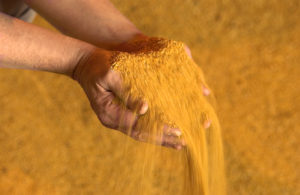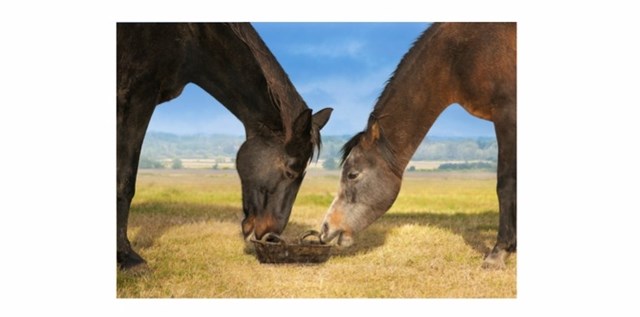By Matt McMillan, Ph.D., Equine Nutritionist, Hi-Pro Feeds
Distiller’s Dried Grains with Solubles (DDGS) are the by-products produced from the manufacturing process of ethanol. These products have been readily available in recent years because of the increase of domestic ethanol production. DDGS have many favorable properties including price, as well as adequate energy and protein values. The utilization of DDGS as a feed ingredient in livestock and horse feeds has become quite common especially in regions where ethanol production facilities are present. Due to the growing interest in DDGS as a feed ingredient, The American Association of Feed Control Officials (AAFCO) defined DDGS as the products obtained after the removal of ethyl alcohol by distillation from yeast fermentation of a grain or grain mixture. DDGS originate from many different grain sources with corn being the most common. In the U.S., ethanol plants have the capabilities to produce more than 14 billion gallons of ethanol and 39 million tons of DDGS annually.
Aside from adequate energy and protein values, DDGS have been shown to have several favorable properties when being considered as a feed ingredient. Because of the processing involved, DDGS contain substantially less starch and sugars (non-structural carbohydrates) than corn from which it originated. This means that most of the non-structural carbohydrates that were present in corn were removed through the distillation process when the alcohol was produced and essentially separated leaving the DDGS as the by-product. On average, non-structural carbohydrate content of corn is ~73% where the average content of DDGS is ~10%. This is a sizeable reduction in non-structural carbohydrate content of feedstuff. Because of the considerable removal of non-structural carbohydrates in the ethanol distillation process, the remaining nutrients in the DDGS are therefore concentrated. While the energy level of DDGS is typically lower than that of corn, energy is provided more through fat source rather than sugars and starches. Some ethanol plants are now removing more fat from the final by-product. Also, protein levels are higher in DDGS than in corn.
DDGS have many favorable properties while used as an ingredient in livestock and horse feeds, some producers attempt to feed DDGS as a sole feed source. While this practice may show some favorable results in the short-term, the long-term results could be detrimental if not fatal. Because DDGS are by-products of the ethanol manufacturing process, quality and nutrient variation can be considerably different especially when sources are received from separate manufacturing plants utilizing different processing and drying systems.
 Quality issues of DDGS can include a wide range of aroma, which may create potential palatability issues when fed as a sole feed source. When considering nutrient differences in DDGS, proteins can range from ~24 – ~34%. Also, lysine digestibility varies due to the level of heating that occurs during the drying process of the DDGS. More importantly, they commonly have phosphorus levels that are higher than calcium levels. The recommended level for calcium and phosphorus in the horse’s diet is 2:1 Ca😛 ratio. When this ratio is inverted, many problems can potentially occur including bone development problems especially in young growing horses as well as head enlargement in older horses causing a condition known as “Big-Head Disease”.
Quality issues of DDGS can include a wide range of aroma, which may create potential palatability issues when fed as a sole feed source. When considering nutrient differences in DDGS, proteins can range from ~24 – ~34%. Also, lysine digestibility varies due to the level of heating that occurs during the drying process of the DDGS. More importantly, they commonly have phosphorus levels that are higher than calcium levels. The recommended level for calcium and phosphorus in the horse’s diet is 2:1 Ca😛 ratio. When this ratio is inverted, many problems can potentially occur including bone development problems especially in young growing horses as well as head enlargement in older horses causing a condition known as “Big-Head Disease”.
Aside from negative properties contained within DDGS when considered a sole feed source, other nutrient issues include those that are not being provided in the horse’s diet, which are necessary for daily maintenance of life. Dependent upon stage of life and level of activity, the horse will need several vitamins and minerals that the DDGS will not provide when fed in a sole feed source situation. Examples of some of these nutrients that are needed include but are not limited to selenium, copper, zinc, and manganese, as well as Vitamins A, D, and E. These minerals and vitamins all play crucial roles in the development and maintenance of soft tissues including tendons, ligaments, and cartilage; the production of enzymes so that performance and reproduction can be maximized to its fullest potential; and in the anti-oxidant defense of free radicals in response to exercise and metabolism. If DDGS are to be fed as the sole feed ration for the horse, then the horse will not receive these necessary minerals and vitamins and at some point will exhibit breakdown whether it be through lameness or reproductive failure. So while DDGS can be utilized for their valuable properties as an ingredient source, it is not advised for it to be fed as a sole feed ration.
To customize your horse’s diet and to make certain that it is receiving all the proper nutrients at the necessary levels needed to maximize its potential, go to our equine products page and click on our Microsteed™ link to apply your horse’s stage of life and level of activity variables. Upon calculation, you will receive a personalized output with a feeding recommendation according to the information that you provided about your horse. This will ensure you that your horse has a truly fortified diet and that it will be receiving all the necessary nutrients to meet its daily requirements.


